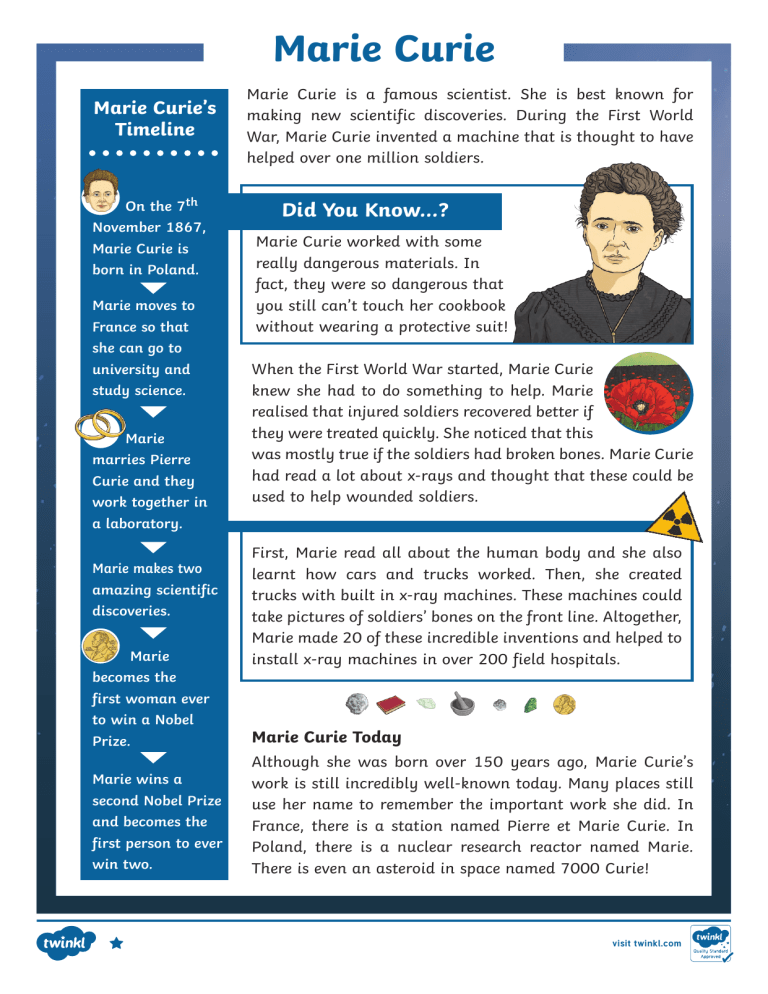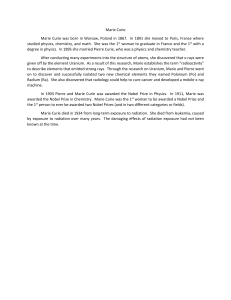
Marie Curie Marie Curie’s Timeline On the 7th November 1867, Marie Curie is born in Poland. Marie moves to France so that she can go to university and study science. Marie marries Pierre Curie and they work together in a laboratory. Marie makes two amazing scientific discoveries. Marie becomes the first woman ever to win a Nobel Prize. Marie wins a second Nobel Prize and becomes the first person to ever win two. Marie Curie is a famous scientist. She is best known for making new scientific discoveries. During the First World War, Marie Curie invented a machine that is thought to have helped over one million soldiers. Did You Know...? Marie Curie worked with some really dangerous materials. In fact, they were so dangerous that you still can’t touch her cookbook without wearing a protective suit! When the First World War started, Marie Curie knew she had to do something to help. Marie realised that injured soldiers recovered better if they were treated quickly. She noticed that this was mostly true if the soldiers had broken bones. Marie Curie had read a lot about x-rays and thought that these could be used to help wounded soldiers. First, Marie read all about the human body and she also learnt how cars and trucks worked. Then, she created trucks with built in x-ray machines. These machines could take pictures of soldiers’ bones on the front line. Altogether, Marie made 20 of these incredible inventions and helped to install x-ray machines in over 200 field hospitals. Marie Curie Today Although she was born over 150 years ago, Marie Curie’s work is still incredibly well-known today. Many places still use her name to remember the important work she did. In France, there is a station named Pierre et Marie Curie. In Poland, there is a nuclear research reactor named Marie. There is even an asteroid in space named 7000 Curie! visit twinkl.com Marie Curie Questions 1. Number the events from 1-4 to show the order that they happened in Marie’s life. Marie Curie wins a Nobel Prize. Marie Curie is born. Marie Curie marries Pierre Curie. Marie Curie moves to France. 2. What did Marie Curie invent during the First World War? Tick one. a a a a medicine to heal broken legs truck with a built-in x-ray machine stretcher new style of cookbook 3. Join the boxes to show where the different places named after Marie Curie are. in space a nuclear research reactor named Marie in France a station named Pierre et Marie Curie in Poland an asteroid named 7000 Curie 4. What is Marie Curie best known for? Tick one. moving to France being born in Poland making new scientific discoveries living over 150 years ago 5. What did Marie realise about injured soldiers? 6. How many soldiers did Marie’s invention help? 7. If you were to go back in time, what question would you ask Marie? Explain your answer. visit twinkl.com Marie Curie Answers 1. Number the events from 1-4 to show the order that they happened in Marie’s life. 4 Marie Curie wins a Nobel Prize. 1 Marie Curie is born. 3 Marie Curie marries Pierre Curie. 2 Marie Curie moves to France. 2. What did Marie Curie invent during the First World War? Tick one. a medicine to heal broken legs a truck with a built-in x-ray machine a stretcher a new style of cookbook 3. Join the boxes to show where the different places named after Marie Curie are. in space a nuclear research reactor named Marie in France a station named Pierre et Marie Curie in Poland an asteroid named 7000 Curie 4. What is Marie Curie best known for? Tick one. moving to France being born in Poland making new scientific discoveries living over 150 years ago 5. What did Marie realise about injured soldiers? Marie realised that injured soldiers recovered better if they were treated quickly. 6. How many soldiers did Marie’s invention help? Marie’s invention helped over one million soldiers. 7. If you were to go back in time, what question would you ask Marie? Explain your answer. Pupils’ own responses, such as: I would ask her ‘How did you feel knowing that you had helped over one million people?’ because that is something that not many people can say they’ve done and I would like to hear her response. visit twinkl.com Marie Curie Marie Curie is a famous scientist who is most famous for discovering two new radioactive elements. During the First World War, Marie Curie invented an incredible machine which is estimated to have helped over one million soldiers. Early Life Marie Curie was born in Poland on the 7th November 1867. Marie’s parents were both teachers and her father would often teach her science at home. When she grew older, Marie wanted to go to university and learn all about physics (an area of science). Unfortunately, at the time women were not allowed to study in Poland. This meant that Marie had to move to France where she was allowed to go to university. Did You Know...? • Marie Curie’s blue laboratory clothes were actually the same outfit she wore when she got married! • The materials that Marie Curie worked with were so dangerous that you can’t even look at her cookbook today Important Work After she had learnt all about physics at university, Marie worked in a laboratory with her husband, Pierre Curie. During this time, Marie made an incredible breakthrough and discovered two new radioactive elements which had never been seen before. Because of her amazing discoveries and work in science, Marie Curie became the first woman ever to win a Nobel Prize (a prize awarded for outstanding work). A few years later, Marie went on to win a second Nobel Prize which made her the first person ever to win two Nobel Prizes! without wearing a full protective suit. Page 1 of 2 visit twinkl.com Marie Curie Marie and the War Fact File When the First World War started, Marie Curie knew she had to do something to help. Marie had realised that injured soldiers recovered better if they were treated quickly. Putting her knowledge and understanding of radiation to good use, Marie decided to invent a machine which could help wounded soldiers close to the battlefields. With this in mind, Marie taught herself anatomy and mechanics and set off to create mobile x-ray machines which could be used on the front line. Marie Curie’s daughter, Irene, helped her and together they were able to install 20 mobile x-ray vehicles and 200 x-ray units at field hospitals during the first year of the First World War. These incredible machines were named ‘Petites Curies’ after the amazing lady who created them. Legacy Although she was born over 150 years ago, Marie Curie’s work is still incredibly well-known. Some treatments being used in hospitals today started out as inventions in her laboratory. In recognition of the incredible work she carried out, the name ‘Marie Curie’ can be found in many different places. For example, in 2007, the ‘Pierre et Marie Curie’ station in France opened up, named after Marie and her husband. There is even an asteroid named the 7000 Curie! Glossary Fact File anatomy: The makeup of living things. mechanics: The study of machines. radiation: Waves that enter the human body. radioactive: Giving off radiation. Page 2 of 2 visit twinkl.com Marie Curie Questions 1. What was Marie Curie the first woman to do? Tick one. go to university work in the First World War study physics win a Nobel Prize 2. What was surprising about Marie Curie’s work clothes? Tick one. they were yellow they were the same clothes she wore to get married she never changed them they were called ‘Petites Curies’ 3. Number the events from 1-4 in the order they occurred. A station in France is named after Marie and Pierre. Marie moves to France. Marie becomes the first person ever to win two Nobel Prizes. Marie Curie becomes the first woman to win a Nobel Prize. 4. Join the numbers to the correct statements. 2 The number of soldiers it is estimated Marie Curie helped. 20 The number of x-ray units Marie installed at field hospitals. 200 The number of mobile x-ray vehicles Marie installed. 1,000,000 The number of Nobel Prizes Marie Curie won. 5. Look at the section titled Important Work. Find and copy two different adjectives that show Marie Curie’s work was impressive. 6. Fill in the missing words. Marie Curie lived in two different countries: Page 1 of 2 and . visit twinkl.com Marie Curie Questions 7. Marie Curie had to move to a new country so that she could go to university. Do you think this was a good idea? Explain your answer. 8. Marie Curie became the first woman ever to win a Nobel Prize. How do you think Marie Curie felt at this point in her life? Explain your answer. Page 2 of 2 visit twinkl.com Answers Marie Curie 1. What was Marie Curie the first woman to do? Tick one. go to university work in the First World War study physics win a Nobel Prize 2. What was surprising about Marie Curie’s work clothes? Tick one. they were yellow they were the same clothes she wore to get married she never changed them they were called ‘Petites Curies’ 3. Number the events from 1-4 in the order they occurred. 4 1 3 2 A station in France is named after Marie and Pierre. Marie moves to France. Marie becomes the first person ever to win two Nobel Prizes. Marie Curie becomes the first woman to win a Nobel Prize. 4. Join the numbers to the correct statements. 2 The number of soldiers it is estimated Marie Curie helped. 20 The number of x-ray units Marie installed at field hospitals. 200 The number of mobile x-ray vehicles Marie installed. 1,000,000 The number of Nobel Prizes Marie Curie won. 5. Look at the section titled Important Work. Find and copy two different adjectives that show Marie Curie’s work was impressive. Accept any two of the following: incredible; amazing; outstanding. 6. Fill in the missing words. Marie Curie lived in two different countries: Poland and France. 7. Marie Curie had to move to a new country so that she could go to university. Do you think this was a good idea? Explain your answer. Pupils’ own responses, such as: I think it was a good idea because if she didn’t go to university then she might not have learnt enough to win a Nobel Prize. 8. Marie Curie became the first woman ever to win a Nobel Prize. How do you think Marie Curie felt at this point in her life? Explain your answer. Pupils’ own responses, such as: I think she felt really happy and proud of herself because she discovered two things nobody else had before. visit twinkl.com Marie Curie Marie Curie is a famous scientist who is best known for her discovery of two FileWorld War, Marie Curie played a new radioactive elements. DuringFact the First vital part and it is estimated that her incredible invention helped over one million wounded soldiers. Early Life Marie Curie was born in Poland on the 7th November 1867. Her parents were both teachers at local schools. Marie’s dad was very interested in science and shared this passion with Marie when she was young. When she grew older, Marie wanted to go to university and study physics (an area of science). Unfortunately, at the time women were not allowed to study in Poland so Marie had to move to France where she was allowed to go to university. Did You Know...? • On her wedding day, Marie Curie wore dark blue clothes instead of a white wedding dress. Surprisingly, this outfit became her work clothes for the next few years! • The materials that Marie Curie worked with were so dangerous that you still cannot look at her cookbook without wearing a full protective suit. Important Work After she had completed a degree in physics, Marie worked alongside her husband, Pierre Curie, with dangerous radioactive materials. During this time, Marie discovered two new elements which had never been heard of before. For her amazing discoveries and work in science, Marie Curie became the first woman ever to win a Nobel Prize. A few years later, Marie went on to win a second Nobel Prize; something nobody else in the world had ever achieved! Page 1 of 2 visit twinkl.com Marie Curie Incredible Invention At the outbreak of the First World War, Marie Curie knew she had to do something to help. Marie had noticed that injured soldiers – especially those with broken bones – recovered better if they were treated quickly. She already had a good understanding of radiation and how it was used to take x-rays so she decided to put this knowledge to good use. Marie then taught herself anatomy and mechanics before creating mobile x-ray machines which could be used on the front line. This meant that soldiers who had been wounded could be treated a lot more quickly. Helped by her 17-year-old daughter, Irene, Marie Curie was able to install 20 mobile x-ray vehicles and 200 x-ray units at field hospitals in the first year of the First World War. These incredible machines were named ‘Petites Curies’ after the amazing lady who created them. LEGACY Many places even use Marie’s name as recognition of the incredible work she carried out. In 2007, the ‘Pierre et Marie Curie’ station in France opened up, named after Marie and her husband. There is even an asteroid named the 7000 Curie! Despite having been born over 150 years ago, Marie Curie’s work is still incredibly well-known. Amazingly, some treatments being used in hospitals today started out as inventions in her laboratory. Glossary anatomy: The structure of the body of living things. mechanics: The study of machinery with moving parts. radiation: Tiny waves that are small enough to enter the human body. Page 2 of 2 radioactive: Giving off radiation. visit twinkl.com Questions Marie Curie 1. Why did Marie Curie move to France? Tick one. Poland was too cold she wanted to help injured people she was allowed to go to university in France she had always loved France 2. When did the Pierre et Marie Curie station first open? Tick one. 1867 2007 150 years ago at the outbreak of the First World War 3. Who helped Marie Curie to install over 200 x-ray machines? 4. Find and copy one word from the first paragraph that means important. 5. What did Marie Curie observe about injured soldiers? 6. What was different about Marie Curie’s life in France compared with her life in Poland? Page 1 of 2 visit twinkl.com Marie Curie Questions 7. How would you describe Marie Curie’s character? Explain your answer. 8. In 2009, Marie Curie was named: ‘The Most Influential Woman in Science’. Do you think she deserves this title? Yes No Fully explain your answer. Page 2 of 2 visit twinkl.com Answers Marie Curie 1. Why did Marie Curie move to France? Tick one. Poland was too cold she wanted to help injured people she was allowed to go to university in France she had always loved France 2. When did the Pierre et Marie Curie station first open? Tick one. 1867 2007 150 years ago at the outbreak of the First World War 3. Who helped Marie Curie to install over 200 x-ray machines? Marie’s daughter, Irene, helped her to install over 200 x-ray machines. 4. Find and copy one word from the first paragraph that means important. Vital 5. What did Marie Curie observe about injured soldiers? Marie observed that injured soldiers recovered better if they were treated quickly. 6. What was different about Marie Curie’s life in France compared with her life in Poland? Pupils’ own responses, such as: When she was in Poland, Marie Curie was not allowed to go to university. When she was in France, she went to university and studied physics. 7. How would you describe Marie Curie’s character? Explain your answer. Pupils’ own responses, such as: I would describe Marie Curie as caring because she looked after one million soldiers in a really dangerous place and put them first. 8. In 2009, Marie Curie was named: ‘The Most Influential Woman in Science’. Do you think she deserves this title? Accept either yes or no as an answer, providing that a full explanation is also given, such as: Yes, because she used her knowledge of science to invent something that helped a lot of people. visit twinkl.com




